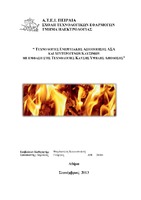| dc.contributor.advisor | Ψωμόπουλος, Κωνσταντίνος | |
| dc.contributor.author | Δημουλάς, Γεώργιος | |
| dc.date.accessioned | 2014-04-29T07:38:49Z | |
| dc.date.available | 2014-04-29T07:38:49Z | |
| dc.date.issued | 2013-09 | |
| dc.identifier.uri | http://okeanis.lib2.uniwa.gr/xmlui/handle/123456789/1199 | |
| dc.description.abstract | Η ολοένα και αυξανόμενη παραγωγή στερεών αποβλήτων, καθιστά τη διαχείρισή τους ζήτημα σοβαρό που απαιτεί την εξεύρεση τρόπων αντιμετώπισής του. Ειδικότερα για την ΕΕ, η τελευταία οδηγία (2008/98) θέτοντας το πλαίσιο διαχείρισης των ΑΣΑ με όρους αειφόρου ανάπτυξης και εξοικονόμησης φυσικών πόρων, συστήνει την επεξεργασία των ΑΣΑ με ταυτόχρονη παραγωγή ενέργειας (αρχή επαναχρησιμοποίησης, ανακύκλωσης, κ.ο.κ). Για τους παραπάνω λόγους, στόχος της εργασίας τούτης είναι να παρουσιάσει τις τεχνολογίες εκείνες που επεξεργάζονται τα ΑΣΑ ώστε να ανακτάται ενέργεια. Αρχικά παρουσιάζονται τα είδη των τεχνολογιών από τη ΜΒΕ όπως η αερόβια και αναερόβια ζύμωση και η βιοξήρανση. Όπως θα παρουσιαστεί, τα δευτερογενή καύσιμα που ανακτώνται όπως τα βιοαέριο, RDF, SRF, συναρτούν τη θερμογόνο δύναμή τους με τον βαθμό καθαρότητας του είδους των αποβλήτων προς επεξεργασία. Επιπλέον, η ανάκτηση ενέργειας δεν φτάνει τα επίπεδα αυτών της Θερμικής Επεξεργασίας. Ακόλουθα, παρουσιάζονται οι τεχνολογίες Θερμικής Επεξεργασίας που δύνανται να παράγουν ενέργεια όπως η καύση - αποτέφρωση, η πυρόλυση, η αεριοποίηση και η αεριοποίηση οργανικού πλάσματος. Όπως παρουσιάζεται, η καύση - αποτέφρωση δύναται να παράξει τα υψηλότερα ποσοστά ενέργειας, είναι δοκιμασμένη τεχνολογία, όμως παράγει ρύπους λόγω της επεξεργασίας σύμμεικτων ΑΣΑ. Αντίθετα, οι υπόλοιπες τρεις τεχνολογίες είναι ιδιαίτερα φιλικές προς το περιβάλλον όμως προϋποθέτουν διαλεγμένα ΑΣΑ και δεν έχουν δοκιμαστεί αρκετά. Επιπρόσθετα, παρουσιάζονται παραδείγματα μονάδων Θερμικής Επεξεργασίας στην ΕΕ με υψηλή ανάκτηση ενέργειας. Όσον αφορά στην Ελλάδα, που έχει 5 Εργοστάσια Μηχανικής Ανακύκλωσης και Κομποστοποίησης, διαθέτει το μεγαλύτερο ποσοστό των ΑΣΑ σε ΧΥΤΑ. Για αυτό γίνεται αποτίμηση βάσει κριτηρίων οικονομικών, περιβαλλοντικών, τεχνικών και θεσμικών – κοινωνικών των τεχνολογιών Θερμικής Επεξεργασίας και διερευνάται η δυνατότητα δημιουργίας μονάδας Θερμικής Επεξεργασίας των ΑΣΑ στην Ελλάδα. | el |
| dc.format.extent | 163 σελ. | el |
| dc.language.iso | el | el |
| dc.publisher | ΤΕΙ Πειραιά | el |
| dc.rights | Αναφορά Δημιουργού-Μη Εμπορική Χρήση-Όχι Παράγωγα Έργα 3.0 Ελλάδα | * |
| dc.rights.uri | http://creativecommons.org/licenses/by-nc-nd/3.0/gr/ | * |
| dc.subject | TPSH::Περιβάλλον::Ανακύκλωση (Απορρίματα, κ.λπ) | el |
| dc.title | Τεχνολογίες ενεργειακής αξιοποίησης ΑΣΑ και δευτερογενών καυσίμων με έμφαση στις τεχνολογίες καύσης υψηλής απόδοσης | el |
| dc.type | Πτυχιακή εργασία | el |
| dc.contributor.department | Τμήμα Ηλεκτρολογίας | el |
| dc.contributor.faculty | Σχολή Τεχνολογικών Εφαρμογών | el |
| dc.subject.keyword | ΑΣΑ | el |
| dc.subject.keyword | Αερόβια μηχανική βιολογική επεξεργασία | el |
| dc.subject.keyword | Βιοξήρανση | el |
| dc.subject.keyword | RDF | el |
| dc.subject.keyword | SRF | el |
| dc.subject.keyword | Καύση | el |
| dc.subject.keyword | Πυρόλυση | el |
| dc.subject.keyword | Αεριοποίηση πλάσματος ΑΣΑ | el |
| dc.subject.keyword | Αστικά στερεά απόβλητα | el |
| dc.description.abstracttranslated | The ever-increasing production of solid wastes is making their management a problem so serious that requires ways to be dealt with. With regards to the EU, the recent Direction (2008/98) sets the framework for the management of MSW in terms of sustainable development and conservation of natural resources and recommends the thermal treatment of MSW with simultaneous production of energy (principle of reuse, recycling, etc). For the reasons above, the aim of this thesis is to present those technologies which process MSW in order to recover energy. Initially, technologies from MBT such as Mechanical Biological Treatment with Composting, Mechanical Biological Treatment with Anaerobic Digestion and Mechanical Biological Treatment with Biodrying are being presented. As it will be shown, the secondary recovered fuels such as biogas, RDF, SRF, associate their thermal power on the degree of purity of the types of waste that are being processed. Moreover, the rates of the energy produced do not reach these levels of Thermal Treatment. Additionally, the technologies of Thermal Treatment that produce energy, like combustion-incineration, pyrolysis, gasification and plasma gasification are presented too. As shown, combustion - incineration can produce the highest energy, are considered a reliable technology, but produce emissions due to the processing of mixed MSW. On the contrary, the other three technologies are more environment-friendly but require chosen MSW and have not yet been tested enough. Additionally, examples of Thermal Treatment plants in the EU with high energy recovery are presented. Regarding Greece, which has 5 Plants for Mechanical Recycling and Composting, has the largest percentage of MSW disposed in landfills. Therefore, thermal treatment technologies are estimated under economic, environmental, technical and social criteria and the possibility of such a plant constructed in Greece is being explored. | el |


